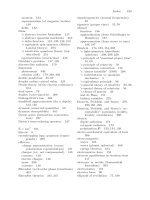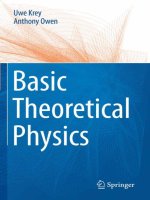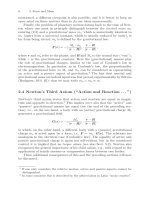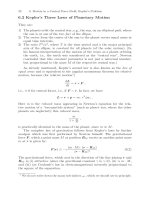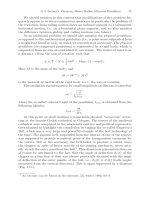- Trang chủ >>
- Khoa Học Tự Nhiên >>
- Vật lý
Basic Theoretical Physics: A Concise Overview P44 pps
Bạn đang xem bản rút gọn của tài liệu. Xem và tải ngay bản đầy đủ của tài liệu tại đây (264.41 KB, 10 trang )
Uwe Krey ·Anthony Owen
Basic eoretical Physics
Uwe Krey · Anthony Owen
Basic Theoretical Physics
AConciseOverview
With 31 Figures
123
Prof. Dr. Uwe Krey
University of Regensburg (retired)
FB Physik
Universitätsstraße 31
93053 Regensburg, Germany
E-mail:
Dr. rer n at habil Anthony Owen
University of Regensburg (retired)
FB Physik
Universitätsstraße 31
93053 Regensburg, Germany
E-mail:
Library of Congress Control Number: 2007930646
ISBN 978-3-540-36804-5 Springer Berlin Heidelberg New York
is work is subject to copyright. All rights are reserved, whether the whole or part of the material is
concerned, specifically the rights of translation, reprinting, reuse of illustrations, recitation, broadcasting,
reproduction on microfilm or in any other way, and storage in data banks. Duplication of this publication
or parts thereof is permitted only under the provisions of the German Copyright Law of September 9,
1965, in its current version, and permission for use must always be obtained from Springer. Violations are
liable for prosecution under the German Copyright Law.
Springer is a part of Springer Science+Business Media
springer.com
© Springer-Verlag Berlin Heidelberg 2007
e use of general descriptive names, registered names, trademarks, etc. in this publication does not imply,
even in the absence of a specific statement, that such names are exempt from the relevant protective laws
and regulations and therefore free for general use.
Typesetting and production: LE-T
E
X Jelonek, Schmidt & Vöckler GbR, Leipzig
Cover design: eStudio Calamar S.L., F. Steinen-Broo, Pau/Girona, Spain
Printed on acid-free paper SPIN 11492665 57/3180/YL - 5 4 3 2 1 0
Preface
This textbook on theoretical physics (I-IV) is based on lectures held by one of
the authors at the University of Regensburg in Germany. The four ‘canonical’
parts of the subject have been condensed here into a single volume with the
following main sections :
I = Mechanics and Basic Relativity;
II = Electrodynamics and Aspects of Optics;
III = Quantum Mechanics (non-relativistic theory), and
IV = Thermodynamics and Statistical Physics.
Our compendium is intended primarily for revision purposes and/or to aid
in a deeper understanding of the subject. For an introduction to theoretical
physics many standard series of textbooks, often containing seven or more
volumes, are already available (see, for example, [1]).
Exercises closely adapted to the book can be found on one of the authors
websites [2], and these may be an additional help.
We have laid emphasis on relativity and other contributions by Einstein,
since the year 2005 commemorated the centenary of three of his ground-
breaking theories.
In Part II (Electrodynamics) we have also treated some aspects with which
every physics student should be familiar, but which are usually neglected in
textbooks, e.g., the principles behind cellular (or mobile) phone technology,
synchrotron radiation and holography. Similarly, Part III (Quantum Mechan-
ics) additionally covers aspects of quantum computing and quantum cryp-
tography.
We have been economical with figures and often stimulate the reader to
sketch his or her own diagrams. The frequent use of italics and quotation
marks throughout the text is to indicate to the reader where a term is used
in a specialized way. The Index contains useful keywords for ease of reference.
Finally we are indebted to the students and colleagues who have read
parts of the manuscript and to our respective wives for their considerable
support.
Regensburg, Uwe Krey
May 2007 Anthony Owen
Contents
Part I Mechanics and Basic Relativity
1 Space and Time 3
1.1 PreliminariestoPartI 3
1.2 GeneralRemarkson SpaceandTime 3
1.3 SpaceandTimeinClassicalMechanics 4
2 Force and Mass 5
2.1 Galileo’s Principle (Newton’s First Axiom) . . . . . . . . . . . . . . . . 5
2.2 Newton’s Second Axiom: Inertia; Newton’s Equation
ofMotion 5
2.3 Basic and Derived Quantities; Gravitational Force . . . . . . . . . . 6
2.4 Newton’s Third Axiom (“Action and Reaction . . . ”) . . . . . . . . 8
3 Basic Mechanics of Motion in One Dimension 11
3.1 Geometrical Relations for Curvesin Space 11
3.2 One-dimensionalStandardProblems 13
4 Mechanics of the Damped and Driven Harmonic
Oscillator 17
5 The Three Classical Conservation Laws;
Two-particle Problems 23
5.1 Theorem for the Total Momentum
(orfortheMotionoftheCenterofMass) 23
5.2 Theoremforthe TotalAngularMomentum 24
5.3 The EnergyTheorem; ConservativeForces 26
5.4 TheTwo-particleProblem 29
6 Motion in a Central Force Field; Kepler’s Problem 31
6.1 Equations of Motion in Planar Polar Coordinates . . . . . . . . . . . 31
6.2 Kepler’s ThreeLawsof PlanetaryMotion 32
6.3 Newtonian Synthesis: From Newton’s Theory
ofGravitationtoKepler 33
6.4 PerihelionRotation 34
VIII Contents
6.5 Newtonian Analysis: From Kepler’s Laws
to NewtonianGravitation 36
6.5.1 Newtonian Analysis I: Law of Force
fromGivenOrbits 36
6.5.2 Newtonian Analysis II: From the String Loop
Construction of an Ellipse to the Law F
r
= −A/r
2
36
6.5.3 Hyperbolas;Comets 37
6.5.4 Newtonian Analysis III: Kepler’s Third Law
andNewton’s ThirdAxiom 38
6.6 The Runge-Lenz Vector as an Additional Conserved Quantity 39
7 The Rutherford Scattering Cross-section 41
8 Lagrange Formalism I: Lagrangian and Hamiltonian 45
8.1 The Lagrangian Function; Lagrangian Equations
of the SecondKind 45
8.2 An Important Example: The Spherical Pendulum
with VariableLength 46
8.3 The Lagrangian Equations of the 2nd Kind . . . . . . . . . . . . . . . . 47
8.4 Cyclic Coordinates; Conservation of Generalized Momenta . . . 49
8.5 TheHamiltonian 50
8.6 The Canonical Equations; Energy Conservation II;
PoissonBrackets 51
9 Relativity I: The Principle of Maximal Proper Time
(Eigenzeit) 55
9.1 Galilean versus Lorentz Transformations . . . . . . . . . . . . . . . . . . . 56
9.2 Minkowski Four-vectors and Their Pseudo-lengths;
ProperTime 58
9.3 The Lorentz Force and its Lagrangian . . . . . . . . . . . . . . . . . . . . . 60
9.4 The Hamiltonian for the Lorentz Force;
Kinetic versusCanonicalMomentum 61
10 Coupled Small Oscillations 63
10.1 Definitions; Normal Frequencies (Eigenfrequencies)
and NormalModes 63
10.2 Diagonalization: Evaluation of the Eigenfrequencies
and NormalModes 65
10.3 A Typical Example: Three Coupled Pendulums
with Symmetry 65
10.4 ParametricResonance:ChildonaSwing 68
11 Rigid Bodies 71
11.1 Translational and Rotational Parts of the Kinetic Energy . . . . 71
Contents IX
11.2 Moment of Inertia and Inertia Tensor; Rotational Energy
andAngularMomentum 72
11.3 Steiner’s Theorem; Heavy Roller; Physical Pendulum . . . . . . . 74
11.4 Inertia Ellipsoids; Poinsot Construction . . . . . . . . . . . . . . . . . . . 77
11.5 The Spinning TopI: Torque-freeTop 78
11.6 Euler’s Equations of Motion and the Stability Problem . . . . . . 79
11.7 The Three Euler Angles ϕ, ϑ and ψ; the Cardani Suspension . 81
11.8 The SpinningTopII:HeavySymmetricTop 83
12 Remarks on Non-integrable Systems: Chaos 85
13 Lagrange Formalism II: Constraints 89
13.1 D’Alembert’sPrinciple 89
13.2 Exercise: Forces of Constraint for Heavy Rollers
onanInclinedPlane 91
14 Accelerated Reference Frames 95
14.1 Newton’s Equation in an Accelerated Reference Frame . . . . . . 95
14.2 CoriolisForce and Weather Pattern 97
14.3 Newton’s “Bucket Experiment” and the Problem
ofInertialFrames 98
14.4 Application: Free Falling Bodies with Earth Rotation . . . . . . . 99
15 Relativity II: E=mc
2
101
PartII ElectrodynamicsandAspectsofOptics
16 Introduction and Mathematical Preliminaries to Part II 109
16.1 Different Systems of Units in Electromagnetism . . . . . . . . . . . . 109
16.2 Mathematical Preliminaries I: Point Charges
and Dirac’s δ Function 112
16.3 Mathematical Preliminaries II: Vector Analysis . . . . . . . . . . . . . 114
17 Electrostatics and Magnetostatics 119
17.1 ElectrostaticFields inVacuo 119
17.1.1 Coulomb’s Law and the Principle of Superposition . . . 119
17.1.2 Integral for Calculating the Electric Field . . . . . . . . . . . 120
17.1.3 Gauss’sLaw 121
17.1.4 Applications of Gauss’s Law:
Calculating the Electric Fields for Cases
of Spherical or Cylindrical Symmetry . . . . . . . . . . . . . . 123
17.1.5 The Curl of an Electrostatic Field;
TheElectrostaticPotential 124
XContents
17.1.6 General Curvilinear, Spherical
andCylindricalCoordinates 126
17.1.7 Numerical Calculation of Electric Fields . . . . . . . . . . . . 131
17.2 Electrostatic and Magnetostatic Fields in Polarizable Matter . 132
17.2.1 DielectricBehavior 132
17.2.2 DipoleFields;Quadrupoles 132
17.2.3 ElectricPolarization 133
17.2.4 Multipole Moments and Multipole Expansion . . . . . . . 134
17.2.5 Magnetostatics 139
17.2.6 Forces and Torques on Electric and Magnetic Dipoles 140
17.2.7 The FieldEnergy 141
17.2.8 The Demagnetization Tensor . . . . . . . . . . . . . . . . . . . . . . 142
17.2.9 Discontinuitiesat Interfaces 143
18 Magnetic Field of Steady Electric Currents 145
18.1 Amp`ere’s Law 145
18.1.1 An Application: 2d Boundary Currents
for Superconductors; The Meissner Effect . . . . . . . . . . . 146
18.2 The VectorPotential;GaugeTransformations 147
18.3 The Biot-SavartEquation 148
18.4 Amp`ere’s Current Loops and their Equivalent Magnetic
Dipoles 149
18.5 GyromagneticRatioandSpinMagnetism 151
19 Maxwell’s Equations I: Faraday’s and Maxwell’s Laws 153
19.1 Faraday’s Law of Induction and the Lorentz Force . . . . . . . . . . 153
19.2 The ContinuityEquation 156
19.3 Amp`ere’s Law with Maxwell’s Displacement Current . . . . . . . . 156
19.4 Applications: Complex Resistances etc 158
20 Maxwell’s Equations II: Electromagnetic Waves 163
20.1 The Electromagnetic Energy Theorem; Poynting Vector . . . . . 163
20.2 Retarded Scalar and Vector Potentials I:
D’Alembert’s Equation 165
20.3 Planar Electromagnetic Waves; Spherical Waves . . . . . . . . . . . . 166
20.4 Retarded Scalar and Vector Potentials II:
TheSuperpositionPrinciplewith Retardation 169
20.5 Hertz’s Oscillating Dipole
(Electric Dipole Radiation, Mobile Phones) . . . . . . . . . . . . . . . . 170
20.6 Magnetic Dipole Radiation; Synchrotron Radiation . . . . . . . . . 171
20.7 GeneralMultipole Radiation 173
20.8 Relativistic InvarianceofElectrodynamics 174
Contents XI
21 Applications of Electrodynamics in the Field of Optics 179
21.1 Introduction: Wave Equations; Group and Phase Velocity . . . 179
21.2 From Wave Optics to Geometrical Optics; Fermat’s Principle 185
21.3 Crystal OpticsandBirefringence 188
21.4 OntheTheoryofDiffraction 192
21.4.1 Fresnel Diffraction at an Edge; Near-field Microscopy 194
21.4.2 Fraunhofer Diffraction at a Rectangular
andCircularAperture; Optical Resolution 197
21.5 Holography 199
22 Conclusion to Part II 203
Part III Quantum Mechanics
23 On the History of Quantum Mechanics 207
24 Quantum Mechanics: Foundations 211
24.1 PhysicalStates 211
24.1.1 ComplexHilbertSpace 212
24.2 MeasurablePhysicalQuantities (Observables) 213
24.3 The CanonicalCommutationRelation 216
24.4 The Schr¨odinger Equation; Gauge Transformations . . . . . . . . . 216
24.5 MeasurementProcess 218
24.6 Wave-particleDuality 219
24.7 Schr¨odinger’s Cat: Dead and Alive? 220
25 One-dimensional Problems in Quantum Mechanics 223
25.1 Bound Systems in a Box (Quantum Well); Parity . . . . . . . . . . . 224
25.2 Reflection and Transmission at a Barrier; Unitarity . . . . . . . . . 226
25.3 Probability Current . . . . . . . . . . . . . . . . . . . . . . . . . . . . . . . . . . . . . 228
25.4 Tunneling . . . . . . . . . . . . . . . . . . . . . . . . . . . . . . . . . . . . . . . . . . . . . 228
26 The Harmonic Oscillator I 231
27 The Hydrogen Atom according to Schr¨odinger’s Wave
Mechanics 235
27.1 ProductAnsatz; the Radial Function 235
27.1.1 Bound States (E<0) 237
27.1.2 The Hydrogen Atom for Positive Energies (E>0) . . . 238
27.2 Spherical Harmonics . . . . . . . . . . . . . . . . . . . . . . . . . . . . . . . . . . . . 239
28 Abstract Quantum Mechanics (Algebraic Methods) 241
28.1 The Harmonic Oscillator II:
CreationandDestructionOperators 241
28.2 Quantization of the Angular Momenta; Ladder Operators . . . 243
